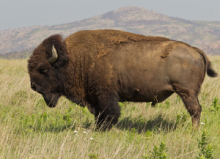Article
A vernacular reference to the North American bison, large herds of which once roamed the North American plains in seemingly endless waves. The bison was an integral component of North American indigenous lifeways throughout the interwest regions. In addition to being a major source of direct subsistence, it also served indigenous communities indirectly in terms of a supporting a thriving economy of exchange founded on bison by-products. The bison was one of the most revered animals in the spiritual belief systems of Native American peoples, and its cultural and material significance cannot be over-emphasized.
Before Anglo-European settlement and the transcontinental railroad, there were approximately thirty million bison roaming the Great Plains. By the mid-19th century, the bison population was depleted to about 100,000 animals because of non-Native profit-driven mass hunting. To those tribes that saw the bison as integral and sacred, this mass hunting was a desecration. Recently, efforts to bring back the numbers of the endangered species have increased the overall bison population to about 250,000.
"Bison (buffalo) at the Wichita Mountain Wildlife Refuge in Oklahoma, May 5, 2012" by katrcool is licensed under CC BY.
Manuscripts
References
Johansen, Bruce E.
2014 Buffalo. The American Mosaic: The American Indian Experience , accessed June 27,
2014.

